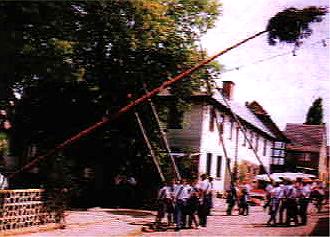 Many, many years ago when I was a seven-year old German girl, with pig-tails dressed in a homemade dirndl (traditional dress), I enjoyed going to the spring festivals in May. Taking a break from running around and gliding down make-shift slides made out of folding tables, I would retreat to a shady spot with my bratwurst and my lemonade to admire the Maypole in our town.
Many, many years ago when I was a seven-year old German girl, with pig-tails dressed in a homemade dirndl (traditional dress), I enjoyed going to the spring festivals in May. Taking a break from running around and gliding down make-shift slides made out of folding tables, I would retreat to a shady spot with my bratwurst and my lemonade to admire the Maypole in our town.
 A Maypole is the pride of every town and village in Bavaria and is erected on April 30th. Its tradition dates back to the 16th or 17th century and became quite popular again in the 18th century. It symbolizes the independence, wealth, and strength of a town. It has always been the job of the men of the town to find, protect, erect, and decorate the Maypole.
A Maypole is the pride of every town and village in Bavaria and is erected on April 30th. Its tradition dates back to the 16th or 17th century and became quite popular again in the 18th century. It symbolizes the independence, wealth, and strength of a town. It has always been the job of the men of the town to find, protect, erect, and decorate the Maypole.
The original meaning of the Maypole dates back to the spring fertility festivals of India and Egypt. The Maypole was decorated with flowers and streamers. The streamers were held by dancers who circled the pole, weaving a pattern as they passed each other during the dance. The pole represents the masculine principle of nature whereas the wreath represents the feminine principle.
Bavarian Maypoles can range from 20 to 30 meters high. The taller the better. The pole must be straight and, in most southern regions, is peeled of its bark. In some towns it will be painted with the Bavarian colors of blue and white. The top of the tree still has the crown that, according to ancient Germanic thinking, kept the strength in the tree (fertility strength).
The poles can also be decorated with the crests of the various craftsmen’s guilds in each town. Beautifully carved and painted ornaments can be found below the wreath.
 Since I was a girl, I really did not get to experience the whole Maypole tradition. It has always been a man’s kind of thing. The only times I ended up under the Maypole were with my boyfriends during one of the summer fests. We were dancing! And, once I was kissed under the Maypole. So, I do have some treasured memories.
Since I was a girl, I really did not get to experience the whole Maypole tradition. It has always been a man’s kind of thing. The only times I ended up under the Maypole were with my boyfriends during one of the summer fests. We were dancing! And, once I was kissed under the Maypole. So, I do have some treasured memories.
It’s the young men of the town that have to watch the tree for several days after it has been cut to keep it from getting stolen by neighboring towns. Each town tries to steal another town’s Maypole. The young men have to sit and guard the pole prior to its festive raising ceremony.
 This April I had one of my weekly telephone calls with my Dad. We talked about the Maypole and he informed me that a 20-meter Maypole was stolen from the highest mountain of Germany (Zugspitze). What? How on earth did they get a tree off a mountain that is 2,962 meters high and covered in snow? Apparently by helicopter. How clever! And expensive. The men have a lot invested in the successful theft of a Maypole.
This April I had one of my weekly telephone calls with my Dad. We talked about the Maypole and he informed me that a 20-meter Maypole was stolen from the highest mountain of Germany (Zugspitze). What? How on earth did they get a tree off a mountain that is 2,962 meters high and covered in snow? Apparently by helicopter. How clever! And expensive. The men have a lot invested in the successful theft of a Maypole.
If a pole is stolen by men of another town, the boys/men must find it and negotiate with the thieves to have it returned. If a tree is not reclaimed by their owners, it will be erected next to the town’s Maypole with some very hilarious sayings about the town’s unwillingness to get their Maypole back.
Negotiation must always include beer and food — given as an exchange — to seal the deal brought on by reconciliation. The Zugspitze thieves also received their customary feast. Although their request for season tickets on the train up to the mountain was denied.
Someone tried to establish a set of "Golden Rules" for stealing and negotiating the return of the pole. Here are some. Poles must be stolen as a covert operation. The cleverer the undertaking, the better. It would be considered a crime to damage the pole in any way. If the thieves are caught hauling off the pole within the town limits, their booty must be returned without a struggle.
 Raised poles can no longer be stolen. Only the tree and not the crests, wreath, or ribbons can be stolen. After reconciliation and exchange, peace must be honored. As strange as it may sound, this code of conduct is honored in most areas with little variations. Men I know in my hometown have grown up with guarding the Maypole. It sounds almost like a fraternity initiation. It is, after all, a testing of their manly courage to defend the honor of their town.
Raised poles can no longer be stolen. Only the tree and not the crests, wreath, or ribbons can be stolen. After reconciliation and exchange, peace must be honored. As strange as it may sound, this code of conduct is honored in most areas with little variations. Men I know in my hometown have grown up with guarding the Maypole. It sounds almost like a fraternity initiation. It is, after all, a testing of their manly courage to defend the honor of their town.
I remember that once another village sawed off our Maypole during the night. There have been rivalries between clubs, and even amongst the younger men, in the various towns, especially if the men dated girls of our town or vice versa. It was mostly the youth soccer clubs or bachelor clubs that spawned some of the rivalries. No war broke out! It was a crime and may have brought dishonor to their town. The guys made up with each other on their terms — making someone pay with a party somewhere, possibly down by the river with camp fire and tents.
Agricultural societies, such as the one I grew up in, still maintain some rituals of ancient cultures. They rely on the fertility of their crops and livestock.
According to our ancestors, a Maypole not only represents fertility but strength. In the 21st century fertility and strength are still a very important trait in a man. Fertility is a sign of prosperity that will strengthen and stabilize family and community life. A modern symbol of prosperity in America is the commercial district of a city erected with skyscrapers that are quite intimidating to a more modest culture.
Trees symbolized fertility and life in many ancient cultures. Even the Christmas tree is a symbol of pagan Germany worshipping the god Thor. It was the Irish missionaries of St. Patrick who incorporated pagan symbols into the Christian faith, making it an acceptable part of Christmas. The Easter egg is another remnant of that time.
On the wedding day of a young couple, birch trees are placed on either side of the entrance to the bride’s family home and often at the entrance to the church. White streamers are hung on the branches for purity. The tree again symbolizes the good wishes for prosperity (be fruitful and multiply).
My “girly” understanding of why the Maypole tradition is still so popular in our area lies with man himself. His need to prove his courage and defend his honor is demonstrated by successfully completing a theft of a symbol through his wit, negotiating the price of its release, and restoring peace to the community.
Young men are given a chance to act out their natural ways of rebellion and competition by learning the skills and abiding in the wisdom of the older men. The man on the watch has to stay alert throughout the night. The man on the negotiating side has to show charisma, a sense of humor, and diplomacy. It is men amongst men.
A young man’s physical strength is especially needed when raising the tree in a vertical position on April 30th. Young and old, men and women, come out to watch. Beer barrels and sausage stands are ready for the townspeople while the men are raising the Maypole. In most cases, it is manual labor requiring strong wooden levers, skill, and strength.
 After the Maypole has been placed into its proper position, the pre-May Day celebration continues. Benches and tables are set up for the May Day celebration. There will be music and people will be dancing on a wooden dance floor or in a local guesthouse. Even a clergy member may stop by for a beer and some mingling. Spring fever seems to be catching. It is the prelude to summer.
After the Maypole has been placed into its proper position, the pre-May Day celebration continues. Benches and tables are set up for the May Day celebration. There will be music and people will be dancing on a wooden dance floor or in a local guesthouse. Even a clergy member may stop by for a beer and some mingling. Spring fever seems to be catching. It is the prelude to summer.
The first of May is a day for being outside. Many people will ride their bicycles and take long hikes through the fields and forests. Without a doubt, a hiker will run into festive activities in any town in Bavaria.
 A couple of years ago I went home to visit Germany with my three kids. I watched my girls play with the German kids at a local festival. They played the same way I used to, by making slides out of benches and tables and gliding down them over and over again. They ran around next to the Maypole, with their bratwurst and lemonade, enjoying their friends and the freedom of being a kid. My then seventeen-year-old son was given a small mug of beer, foaming at the rim, by his grandfather with a silent understanding that it is acceptable to drink amongst adults. From my standpoint, I saw it as my father looking out for his grandson and allowing him to be a young man. There was nothing shameful about it. He was given permission to drink in the open (although he wasn’t too crazy about the taste).
A couple of years ago I went home to visit Germany with my three kids. I watched my girls play with the German kids at a local festival. They played the same way I used to, by making slides out of benches and tables and gliding down them over and over again. They ran around next to the Maypole, with their bratwurst and lemonade, enjoying their friends and the freedom of being a kid. My then seventeen-year-old son was given a small mug of beer, foaming at the rim, by his grandfather with a silent understanding that it is acceptable to drink amongst adults. From my standpoint, I saw it as my father looking out for his grandson and allowing him to be a young man. There was nothing shameful about it. He was given permission to drink in the open (although he wasn’t too crazy about the taste).
The Maypole custom is definitely a guy thing. Men have their laws and rules, and they have their ways of guarding their prosperity. The women stay out of the competition and negotiating. We left it up to our guys to protect our town’s honor. By the time we saw them again at the festival, they had a story to tell us. And the men, of course, were heroic regardless of what happened!
Not many customs are left these days for young men to go through their natural tendency to rebel with the endorsement of community. Although some religions have a spiritual initiation for young boys to turn into young men, it is not as common as perhaps it once was. When it does happen, they will then obey another set of rules and, we hope, mature. A teenage boy’s need to prove himself in modern society is often left to sports. The emphasis is on competing to win at all cost. Some kids are left to their own devices and can be drawn into gang environments where their rebelliousness is used against community. They lack the guidance of ancient customs that promote the good of the whole. Some kids are blessed to have wise parents who know what to do.
The old custom of the Maypole still offers that streak of man an opportunity to act out, but with the endorsement of a community that strives for an exchange that encourages more of a Gemtlichkeit atmosphere rather than a criminal one. Wisdom knows to give enough room to the human heart to learn its lessons.
 Biblical truth can mold these lessons into valuable insights that can make a young man into a man of responsibility who is accountable for his actions. The symbol of the Maypole is then elevated to a higher place. The masculine principle of fertility and strength must also contain the humble and meek spirit of the feminine to make these lessons prosper for the good of all.
Biblical truth can mold these lessons into valuable insights that can make a young man into a man of responsibility who is accountable for his actions. The symbol of the Maypole is then elevated to a higher place. The masculine principle of fertility and strength must also contain the humble and meek spirit of the feminine to make these lessons prosper for the good of all.




